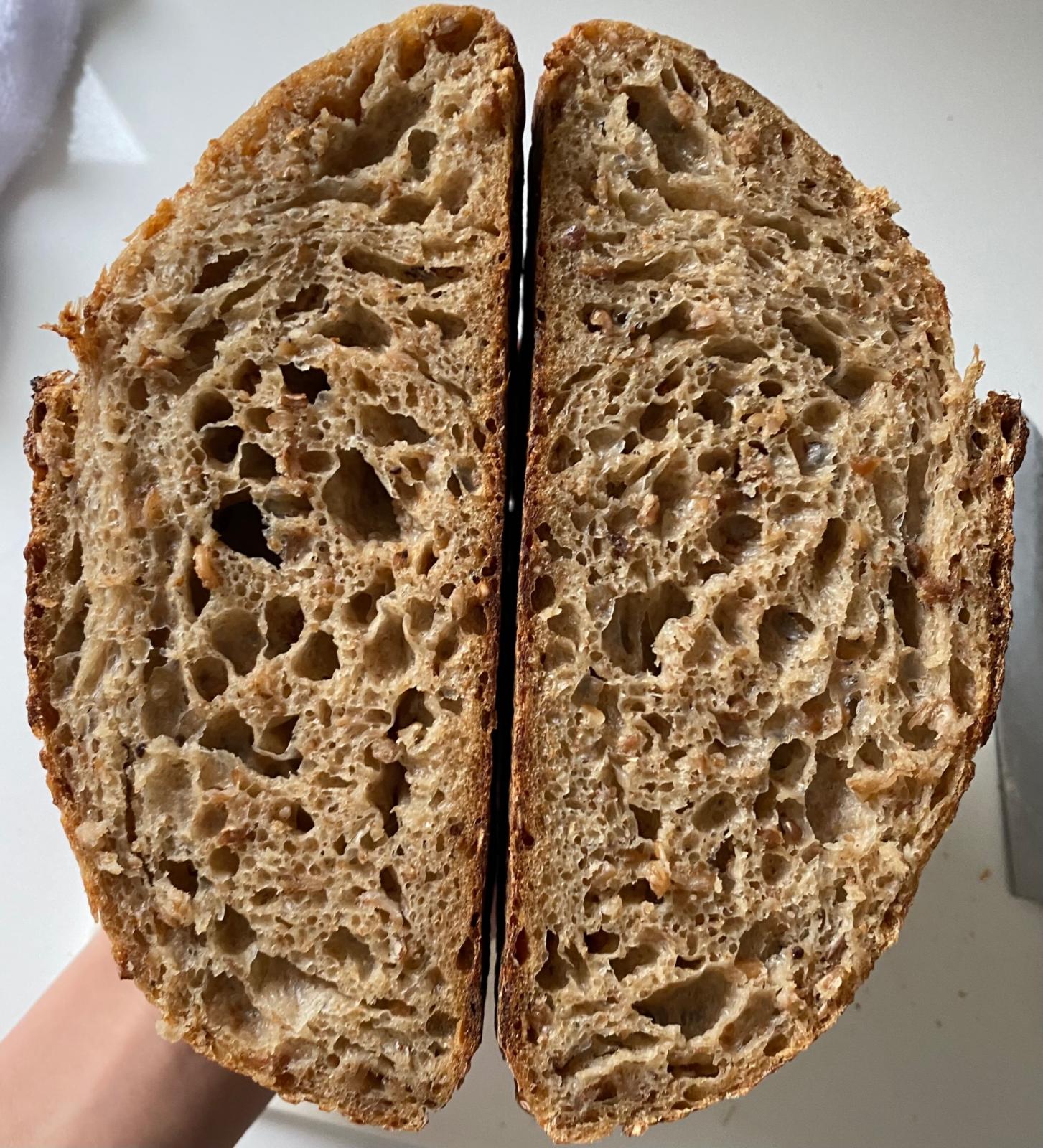
Need some sourdough advice

Second bake with a relatively new starter. Used Joshua Weissemen’s recipe.
Levain: 17.5g starter, 17.5g ww, 17.5g ap, 35g water
Bread: 402 bread flour, 32.5g ww, 370g water, 8g salt
Did two sets of slap and folds before and after adding salt. 6 stretch and folds. Bulk ferment was about 4.5 hours long. Rtp is about 24-25c. Proofed overnight in the fridge for around 13 hours. Baked in a Dutch oven with lid for 20minutes and 20minutes without lid.
how do I get more oven spring? My bread still looks a bit pancakey. I let the dough cool for a good 1-2 hours and cut I to it while it was still slightly warm. The crumb is very slightly sticky when you touch it. Taste and texture wise it’s very good. Crumb sticks slightly to teeth while eating, maybe bulk fermentation went on for too long?


Looks fine. Enjoy!
Looks fine. Enjoy!
When my bread comes out a bit flattened it's invariably due to bulk fermentation going too long. I judge that by how much the volume increases during bulk fermentation. I find that about 2 to 2.5 times seems ideal, though I've gotten some very nice loaves going on either side of that range.
The sticky crumb suggests to me that it isn't quite fully baked. I go 30 minutes in a dutch oven with the lids on, then 15 minutes with them off, in a 475° oven. You didn't say what your oven temp is so I don't know how that compares to my method. I often check the internal temp of my loaves with a thermapen; they are consistently between 206° and 210°. The crumb is very nice and open and quite moist, but not sticky the way yours is. I'd try baking a bit longer or raising the temp to address that.
My recipes are based off of Ken Forkish's book Flour, Water, Salt, Yeast so I don't know how Weissmen's method may differ. I normally use about 230g levain in a recipe with 1000g of flour, and my bulk fermentation ranges from about 6 to 10 hours, depending on the temperature and the flour I'm using (using home milled flour speeds up the fermentation). My target rise for the bulk fermentation is about 2 to 2.5 x. I have found that if bulk fermentation goes too long the dough will triple or more and the oven spring is diminished, but your bulk fermentation isn't very long. Again depending on the recipe I will either proof for 2 to 3 hours at room temp, or overnight in the fridge.
I hope this helps, good luck!
I find it quite hard to judge when my dough has doubled in size. I've seen people cut out a piece of dough and put it into a separate cylindrical container to better see the results but I don't really like wasting dough and don't have a small enough container where I wouldn't be wasting much dough. Do you have any advice on this?
I baked my dough at 260c convection for 20minutes lid on and 230c convection lid off. I preheated the dutch oven for about 40 minutes though I put the dutch oven into the oven while the oven was cold so some time was spent with the temp not being at 260.
I also saw a post about convection being good for roasting but not necessarily for baking. Is this true and if so should I use the heating elements in my oven instead of convection?
Last question, the crust on my bread goes soft very quickly. How do I fix this? Is this an issue with the baking or an issue with storing? I normally cut into my bread when it's cooled and then put it into a ziplock bag if it hasn't been finished to store overnight.
Thanks for the advice as always.
I do my bulk fermentation in a large clear cambro tub so I can see how it's doing. As soon as I've finished preparing the dough I flatten it out so the height is pretty uniform, then I put a large rubber band around the tub with the top of the rubber band aligning with the top of the dough. It won't be perfect because the dough is never perfectly uniform, but it's plenty good enough to tell when it's doubled or tripled or whatever.
You are correct to put the dutch oven in the oven when it's cold, so everything comes up to temperature uniformly. I use an accurate oven thermometer to make sure the oven is fully at temperature. My oven, and I think most ovens, typically overshoot the set temperature, then come back down to it. I find it takes at least an hour for the oven and the cast iron pots to stabilize at 475° F. I don't have a convection oven, but I have heard they behave very differently for baking bread. I'd try it with the conventional heating elements until you've got it working, then if you want to experiment with convection you can.
My crusts usually stay pretty crisp even after putting them in plastic bags—making sure they are fully cooled before doing that. But this may be related to the stickiness of the bread—you may not be fully baking the dough. The other thing I can think of is to leave them in the oven a little longer with the lids off, to crisp up the crust.
BTW, King Arthur Baking Company (formerly King Arthur Flour) has an excellent free toll-free baker's support line that you can call and talk to a master baker. They've been invaluable to me.
Good luck!
I think when using convection you're meant to do 20c lower than conventional. For baking, what temp on a convectional oven would you recommend?
475°F, I think that's about 245°C.